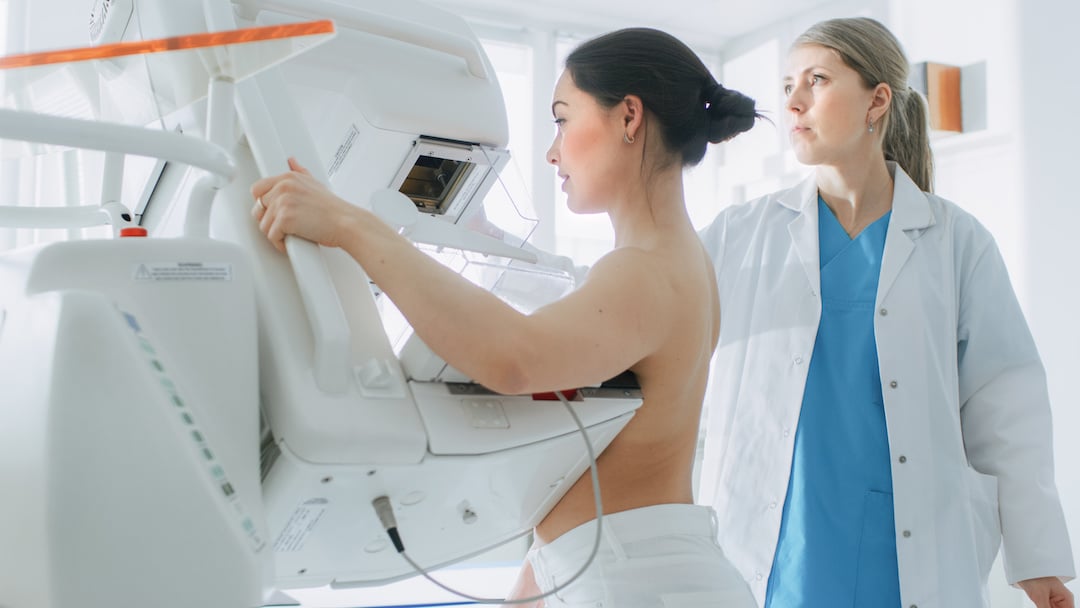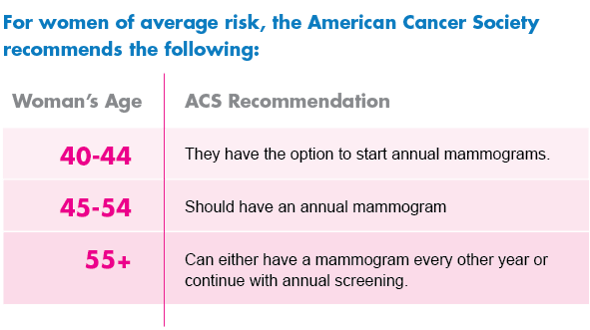
A lot of women are nervous about mammograms. Mammograms are a routine screening tool for early detection of breast cancer in middle aged to older women. It's effective, inexpensive, and non-invasive, although it can be a little uncomfortable.
When Should You Have Your First Mammogram?
The American Cancer Society suggests that women should consider being screened at 40 but, should definitely start no later than age 45. Ultimately, the decision is yours and should depend on your risks of developing breast cancer. If you have a parent, sibling, or child with breast cancer, you should start screening earlier. The same is true if you have tested as positive for the BRCA1, BRCA2 or PALB2 genes that are known to increase breast cancer risk. You should discuss with your doctor what your personal risk levels are. 
The breast cancer specialists at Virginia Oncology Associates have created this video as a guide to breast cancer screening. For more information regarding mammograms and who needs them, visit this article.
What to Expect During the Mammogram:
You should book your mammogram at a specialist imaging clinic. Some clinics will accept walk-ins, but most will require that you make an appointment. Your doctor may refer you to a specific facility. Make sure the clinic accepts your insurance before making an appointment.
When you arrive at the clinic, you will have to show your insurance paperwork and fill out a health history form. They will want to know whether you have a personal or family history of breast or ovarian cancer, whether you have had any kind of breast surgery including implants or breast reduction surgery, whether you are on birth control, whether you have gone through menopause, etc.
You will then be shown to a private changing room where you will disrobe from the waist up and put on a gown. The technician will come to get you and may check some details of your history before escorting you to the mammography machine. Adjustments may need to be made to the machine to ensure that the plate is the right height and to make the entire process more comfortable and to ensure good quality images or obtained.
She will instruct you how to stand and position your breast on the plate. The machine will lower a second plate, which will flatten your breast briefly – this is usually only for a few seconds. Although being "squished" is uncomfortable, it should not be painful (tell the technician if it is). They will take at least two images of each breast, usually adding up to 20 to 25 minutes in the room. They may sometimes have to take a picture again.
Nobody else will be in the room with you. Once the pictures are taken you will be free to get dressed and leave.
When will you receive the results?
Usually, you will get the results within 10 days. A radiologist will study the images and look for abnormalities.
If they see nothing unusual, they will say so. If they see something uncommon, you may be called back for further screening. You may also be informed you have dense breast tissue which means your breasts are harder to see through. This is more common if you are younger, physically fit, have never had children, or are taking hormones for menopause. If you have both dense breast tissue and an elevated risk, they may recommend that you have a breast MRI. It increases your risk of a call back because it makes your mammograms harder to read and it may be associated with slightly higher risk.
Keep in mind that while mammograms are safe, false positives (when the mammogram shows an abnormality which is either not there or is completely benign) are fairly common. Callbacks are particularly common after first mammograms, and the vast majority turn out to be nothing to worry about.
What if you receive a call back?
If you are called back for additional checks, you will most likely receive a second more detailed mammogram. The procedure is the same, but they will take more pictures, and only of the breast showing an abnormality. They may also do an ultrasound test or a breast MRI. The last is generally reserved for situations of greater concern because it is an expensive and lengthy test.
For a diagnostic mammogram, the radiologist will be present and will review your images right away. Reassuringly, fewer than one in ten women who are called back turn out to have cancer. You may also be told to come back in six months to check it again. The radiologist may also order a biopsy. That means they will take a small piece of tissue, most often with a needle, to be carefully examined; however, most biopsies turn out not to be cancer.
How Can You Make a Mammogram Easier?
You should do a few things to help make your mammogram less unpleasant:
- Don't wear any deodorant, body spray, talcum powder, etc. These things can interfere with the machine's ability to get a good picture.
- Don't wear a dress, otherwise you may have to disrobe completely. The imaging center's gowns may not give you the best coverage. Ideally, wear a top you can just pull on and off, such as a t-shirt, to save time.
- Don't schedule a mammogram the week before you expect to start your period because of breast tenderness. You should also talk to your doctor if you are breastfeeding, and you may want to put off your mammogram if you have an injury to your breasts or an infection.
- Avoid wearing valuable or sentimental necklaces. You will have to remove any neck jewelry and worrying about it being stolen is not going to help your mood.
- Avoid caffeinated beverages and chocolate before the procedure, as they can make your breasts sensitive. Save the chocolate as a reward for afterwards.
- Consider taking ibuprofen, especially if you know your breasts tend to be sensitive. If unsure, check with your doctor.
- Drink plenty of water before the mammogram, as this can help both with discomfort and getting good pictures.
- Tell the clinic if you have a latex allergy so the technician can use non-latex gloves.
Mammograms are unpleasant, but generally not painful. Fortunately, they don't take very long and have no side effects after the procedure. If you have a call back, then discuss things with your doctor. Always discuss your screening options so you can make an informed decision about when and how often to have a mammogram.
You should always double-check with your health insurance company, but most policies cover yearly mammograms as part of preventative care. If you do not have insurance, Medicaid and Medicare typically cover all or most of the cost of the mammogram. However, if you do not have insurance and do not receive Medicaid or Medicare, there are other options.
If you are local to Virginia Oncology Associates, the Virginia Department of Health offers the Every Woman's Life program to help uninsured, low-income women gain access to free breast and cervical cancer screening services. We also provide additional information and resources through breast cancer specific organizations in the Cancer Resources section of our website.
It’s too important to skip your mammogram so make sure you get one scheduled, if you haven't already!





